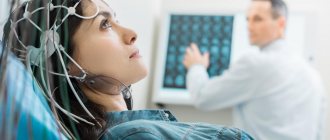Menstrually associated migraine during menstruation
Intense and prolonged migraine attacks in women are often observed during the premenstrual period . This happens because by the end of the cycle (late luteal phase), the level of estrogen and progesterone decreases significantly. And the lower this level, the more pronounced the migraine will be.
The risk period begins 5 days before menstrual bleeding and can span 2–3 days of the next cycle. If attacks occur during this period of time and are not observed in other phases of the cycle, then this form of the disease can be called true menstrual migraine .
Menstrual migraine is very common
If a patient experiences migraine attacks during the premenstrual period, but also occurs during other phases of the cycle, this form of migraine is menstrually associated .
Migraines can also be triggered by the period of ovulation, when the level of estrogen decreases and progesterone begins to rise, as well as fluctuations in the level of other sex hormones.
Features of migraine in women
Migraine Treatment Methods
Migraine treatment is a complex and lengthy process that requires an individual approach to each case of the disease. Treatment measures are aimed at reducing the frequency, duration and severity of attacks, and during an attack, at reducing the severity of symptoms.
Drug treatment of migraine should be accompanied by appropriate lifestyle adjustments. You should avoid overwork, spend more time in the fresh air, follow a sleep and eating schedule, and exclude foods that can provoke attacks.
Neurologists at the Family Doctor will help you quickly and effectively eliminate migraine pain and select an individual course of preventive treatment, including massage and reflexology sessions.
Specialist consultation
The doctor’s task is to select the necessary set of medications. This complex includes drugs that can help in the acute period, as well as drugs aimed at preventing attacks.
Make an appointment Do not self-medicate. Contact our specialists who will correctly diagnose and prescribe treatment.
Rate how useful the material was
thank you for rating
Migraine and PMS
About 70% of all women with PMS complain of migraine. The relationship between migraine and premenstrual syndrome is obvious, but scientists still find it difficult to determine what comes first: migraine due to cyclically changing hormone levels or PMS as a result of migraine attacks
Premenstrual syndrome (PMS) is a complex of pathological symptoms that occur cyclically before the onset of menstrual bleeding and cease after the onset of menstruation. Many women in the days before menstruation experience disorders of a vegetative and affective nature: for example, abnormal hunger, swelling, insomnia, tearfulness and irritability.
The development of premenstrual syndrome is based on genetic predisposition, stress, depression, frequent pregnancy and childbirth, which is an additional burden on the hypothalamus, which regulates the neuroendocrine system.
The combination of premenstrual syndrome and menstrual migraine is associated with a lack of estrogen and progesterone at the end of the luteal phase of the menstrual cycle, as well as an increase in the level of prostaglandins and impaired serotonin production.
Migraine symptoms
Migraine pain is throbbing and pressing on one side of the head.
They are predominantly localized in the temple area and behind the eyes. Sometimes pain initially occurs in the back of the head and only over time moves to one part of the head. The localization of pain may change - at first the pain is on one side, but a subsequent attack of pain may be on the opposite side. Often the development of pain is preceded by a deterioration in the general condition (precursors or prodrome): muscle weakness occurs, the person is unable to concentrate. After a migraine attack, you also feel weak and the skin becomes pale.
During headaches, nausea, decreased appetite, and increased sensitivity to light are possible. More intense sensations are observed during physical activity and walking. In women, a migraine attack can trigger menstrual bleeding. The situation worsens while taking hormonal contraceptives.
Migraine during menopause
At the age of 45-50 years, when ovarian function declines, the nature of migraine in many women changes. For some, the attacks disappear forever, for others the symptoms weaken, but can still occur from time to time, less often - they occur with the same frequency. It depends on individual reasons: the initial form of the disease, health status, nervous excitability, external factors.
With the onset of menopause, migraine control and prevention becomes more difficult due to irregular periods. A migraine attack during this period can be caused by: hot flashes, sweating, changeable mood, stress, lack of sleep.
Some women note that during premenopause, migraine attacks associated with menstruation appear more often and feel stronger. This is caused by disruptions in hormonal regulation: the ovaries produce less of the hormone estrogen than before. At the age of menopause, migraine attacks often virtually disappear.
Evgeniya
“My migraines usually start with an aura. It can be different. In my case, it’s as if I’m inside a soap bubble, from which, firstly, it’s very hard to hear, and secondly, the world around me shimmers with all the colors of the rainbow. In addition, olfactory hallucinations begin, and very funny ones at that. For example, from the last one: while walking my dog in the forest, I smelled smoked sausage. From time to time I smell metal or alcohol - and this is definitely a sign of an impending migraine. I learned about this symptom from American migraine groups, which I read all the time: they discussed that olfactory hallucinations are very often a precursor to migraines.
I have several types of migraines: the most common are a reaction to changes in atmospheric pressure. In addition, there are hormonal and stress migraines. After undergoing long-term therapy, I learned to regulate stress quite well. The weather is absolutely not controlled in any way. True, I have low blood pressure, and from time to time I drink a lot of coffee, which sometimes manages to pull me out of an attack. But, unfortunately, at some point the migraine may start again - already because I drank too much coffee. That is, it’s difficult to understand: your head hurts because the atmospheric pressure is jumping again or because coffee is already flowing through your veins instead of blood.
Sometimes I get migraines without pain, just an aura. In such a situation, I can’t think, I can’t work, the general condition is very unpleasant, but I can tolerate it. And the most hellish pain is hormonal migraines. Here it comes to trips to the hospital. I noticed that with hormonal migraines I do not have enough oxygen, and the doctor prescribed it to me. I have an oxygen cylinder next to my bed, and I can periodically put on an oxygen mask (the heroine lives in Sweden, editor's note).
Of the non-drug ways to combat migraines, I use heat and cold. I have gel pads that I keep in the freezer. When an attack begins, family members carry them back and forth - in our house this is called “bringing cartridges.” In addition, I have a soft toy - a sheep with filling and lavender, which can be heated in the microwave. I also read this method on the forum. If a person can lie down, then it is better to lie down, but the legs should be slightly higher than the level of the head. I place the cold at the base of the skull and the hot sheep under my feet. And this often makes my condition easier.”
Treatment of menstrual migraine
Effective treatment and prevention of migraine depends on the active participation of the patient, compliance with all doctor’s recommendations, a healthy lifestyle and attention to one’s well-being.
Basic measures to prevent and relieve headaches:
Lifestyle
The main preventive measures for migraine associated with the menstrual cycle are:
- development of a rational work and rest regime;
- relieving psycho-emotional stress in the period before menstruation;
- exclusion of frequent migraine provocateurs: oversleeping or lack of sleep, stress, alcohol, nicotine, caffeine;
- adherence to nutritional principles;
- pharmacotherapy in special cases.
Diary of attacks
The diary is filled out to establish coincidences between attacks and days of the menstrual cycle. The time of the attack, the intensity of the symptoms, and the phase of the cycle are recorded. This method makes it possible to accurately establish or exclude the relationship between migraine attacks and menstruation.
Visit doctor
After making a diagnosis, the doctor informs the patient about the etiology of migraine and provoking factors, favorable prognosis and possibilities for effective treatment, the purpose of treatment, the effectiveness of drugs, their side effects and interactions with other drugs.
Drugs
To relieve headaches with menstrual and hormone-associated migraine, as with its other forms, analgesics and NSAIDs are prescribed. But migraines associated with the menstrual cycle are often difficult to respond to painkillers.
If these drugs are ineffective, your doctor may prescribe ergotamine derivatives or triptans. They stop migraine attacks at the very beginning, acting directly on the cause of the pain. In modern pharmacology, triptans are considered the most effective drugs for many types of migraine, including menstrual migraine.
Sumatriptan - description of the drug
Hormone therapy
A clear association of the occurrence of migraine attacks with cycle fluctuations opens up the possibility of preventing attacks through the use of hormonal contraception. Women with menstrual migraine are recommended to take monophasic birth control pills containing estrogens in low concentrations or only progesterone. For migraine with aura, it is undesirable to take combined contraceptives containing estrogen; there is a risk of increasing the risk of stroke and thrombosis; in this case, drugs containing only progesterone are recommended.
During menopause, women are recommended to undergo replacement therapy . Such drugs stabilize the parameters of sex hormones, mainly the level of estrogen. During menopause, it is not recommended to use the synthetic estrogen ethinyl estradiol for hormone replacement therapy due to side effects: tendency to blood clots, increased blood pressure, impaired liver function. Natural estrogens and their analogs are used, which are included in monophasic, biphasic and triphasic preparations.
MIGRAINE IN WOMEN (the role of sex hormones)
The newsletter was prepared by the Secretary of the AGE, Ph.D. L.M. Ilina based on articles by T.G. Voznesenskaya (RMJ, 1999), O.V. Vorobyova (RMJ. Neurology, 2004), T. Vincent et al. (Headache, 2006;46 (1 and 3), L. Brookes (Medscape Cardiology, 2006;10 (2), etc.
MIGRAINE IN WOMEN (the role of sex hormones)
Migraine is one of the most common types of headaches. In women, migraine occurs three times more often (in approximately 27% of women during reproductive age) than in men, and exceeds the incidence of diseases such as diabetes, osteoarthritis and bronchial asthma. In more than 50% of women, the disease occurs for the first time before the age of 20, often during puberty. As a rule, visits to doctors for migraine increases at 20-25 years of age and remains at this level until approximately 40 years of age. The frequency and nature of manifestations of the disease are significantly influenced by hormonal changes that occur in the dynamics of the menstrual cycle, during pregnancy, perimenopause, when taking combined oral contraceptives (COCs) and hormone replacement therapy (HRT). In addition to a sharp decrease in quality of life, migraine has an important medical and social significance, since in women suffering from certain forms of it, after the age of 45, the risk of ischemic stroke increases.
Classification. Migraine with aura (classic migraine) is less common (in approximately 20% of all migraine patients) than migraine without aura (simple migraine). In most patients, the aura that precedes an attack of headache and lasts from 5 to 20 minutes is visual and manifests itself in the form of flashes of light, blind spots (scotomas) or hemianopsia (loss of one of the two fields of vision). Less commonly observed are transient neurological symptoms such as paresthesia, numbness of the tongue, cognitive impairment (usually aphasia), panic disorders (“panic” migraine), etc. Menstrual migraine. According to the International Headache Society, menstrual migraine (MM) is migraine without aura and is divided into two subgroups. 1. “true MM” - headache attacks occur exclusively on perimenstrual days (2 days before menstruation and the first three days after its onset); 2. “migraine associated with menstruation” - in 2/3 of menstrual cycles, headache attacks occur on perimenstrual days, but can also occur on the remaining days of the cycle. In the population, MM occurs in approximately 3% of cases, but among women suffering from migraine, this percentage is much higher: according to various sources, migraine associated with menstruation - in 35% - 51% of cases, and true MM - in 7% - 19% of cases .
Etiopathogenesis. It has been shown that vascular, nervous and endocrine-humoral mechanisms are involved in the genesis of a migraine attack. Most authors point to a hereditary predisposition to this disease, since 50-60% of patients had parents who suffered from true migraine or various forms of autonomic-vascular disorders. Central neurovascular dysregulation manifests itself in the development of endothelial dysfunction, disruption of the metabolism of the most important brain monoamines (especially serotonin) and the endogenous opioid system, etc. Sex hormones have a pronounced modulating effect on these mechanisms. MM appears to result from an “inappropriate” CNS response to “normal” changes in sex hormone levels, as there were no differences in absolute sex hormone levels compared to women with non-menstrual cycle migraine. In a number of studies carried out back in the 70s of the last century, it was convincingly shown that it is the decrease in estrogen levels in the late luteal phase (less than 45-50 pg/ml) that is the initial link in the chain of other neurohumoral changes and plays the role of a triggering factor for an attack MM. Intramuscular administration of estrogens (but not progesterone) immediately before the onset of menstruation, as well as the administration of estrogens in the form of a patch or gel on perimenstrual days, stops an attack of MM. For most women, the course of migraine improves in the second and third trimesters of pregnancy, as well as with increasing duration of postmenopause. However, with migraine with aura, some women may experience an increase in the frequency and severity of headache attacks during pregnancy, which is characterized by high, stable levels of estrogen, as well as when using COCs containing the highly active synthetic estrogen ethinyl estradiol. Thus, with moderate and high estrogen levels, the frequency of migraine attacks without aura may decrease and, conversely, the course of migraine with aura may worsen. The trigger mechanisms for the two migraine subtypes appear to be different. Of course, a sharp decrease in estrogen levels is not the only pathogenetic link in MM. It is known that the level of prostaglandins (PG) in the endometrium increases 3 times by the end of the luteal phase of the cycle (the maximum concentration is observed in the first 48 hours of menstruation). The entry of a significant amount of PG into the general bloodstream during this period can initiate, in addition to headaches and pain in the lower abdomen, nausea, vomiting and other symptoms. Some researchers believe that low magnesium levels may also play a role as a precipitating factor, since magnesium ions are involved in the functioning of cerebral vessels and the central nervous system, due to the release of the most important vasodilator of nitric oxide, serotonin, as well as inhibiting the passage of calcium ions through membrane channels, in addition, they are cofactors for many essential enzymes. There is evidence of relief of an attack of MM when magnesium supplements are prescribed 15 days before the expected menstruation. It is believed that a decrease in the level of sex hormones during the perimenstrual period (late luteal and early follicular phases), which contributes to an increase in the activity of the “excitatory” neurotransmitter glutamate and, conversely, a decrease in opioid, GABAergic and serotonergic tone, as well as an increase in the concentration of PG and magnesium deficiency play a major role in the pathogenetic mechanisms of MM and increase the body’s sensitivity to the effects of provoking factors. The appearance of migraine with menarche, the presence of MM and premenstrual syndrome during reproductive age, and the development of pronounced vasomotor symptoms in peri- and postmenopause indicate an increased “sensitivity” of such women to changes in the level of sex hormones.
MANAGEMENT OF PATIENTS WITH MIGRAINE Lifestyle changes: regular, adequate sleep (both insufficient and excess sleep must be avoided); regular meals, eliminating or reducing the consumption of foods containing tyramine (chocolate, cocoa, nuts, citrus fruits, beans, tomatoes, celery and cheeses), alcoholic beverages (including dry wine, especially red, champagne, beer) regular exercise (swimming , skiing, walking, cycling), which should be fun. It must be remembered that a good mood, positive emotions, the ability to relax and resist stress prevents the development of migraine attacks.
Drug treatment. Migraine treatment is divided into two parts: 1. relief of an already begun migraine attack; 2. preventive measures during the interictal period. 1. In most patients with migraine, treatment is limited to stopping attacks. It should be noted that attacks of MM are more difficult to treat than those not associated with the menstrual cycle. When choosing a specific dosage form to relieve a migraine attack, it is advisable to start with simple or combined analgesics, as well as non-steroidal anti-inflammatory drugs (ibuprofen, paracetamol, metamizole, etc.). The latter have a local (inhibition of pain mediators at the level of the endings of sensory nerves) and a central effect, inhibiting the enzyme cyclooxygenase, they inhibit the synthesis of PG in the central neuronal synapses involved in the transmission of nociceptive (pain) impulses. For MM, non-steroidal anti-inflammatory drugs are prescribed 2-3 days before the expected menstruation + all menstrual days. Such therapy can be classified as preventive, while the powerful local effect of these drugs at the local level also helps to relieve dysmenorrhea and reduce blood loss. If there is no effect from the above drugs, you should proceed to the prescription of ergotamine drugs (dihydroergotamine, dihydroergotamine mesylate). The initial dose is 1-2 mg of ergotamine, if necessary, the dose can be repeated after 30 minutes, the total dose should not exceed 5 mg per attack or 10 mg per week. The effectiveness of ergotamine drugs is higher when using parenteral agents (rectal suppositories, nasal spray). It should be remembered that diseases such as coronary heart disease, arterial hypertension and peripheral vascular disease are contraindications for the use of these drugs. In severe cases, a headache specialist prescribes selective serotonin agonists: sumatriptan at a dose of 50 mg (no more than 3 tablets per day with an interval of at least an hour); naratriptan in a dose of 2.5 mg, in the absence of effect, the subsequent dose is used no earlier than 4 hours later, the maximum daily dose is 5 mg, for the prevention of MM - in a dose of 2.5 mg 1 time per day on perimenstrual days. It should be emphasized that the need for frequent use of these potent drugs indicates incorrectly selected preventive therapy. 2. Preventive treatment is prescribed only for frequent and severe migraine attacks or in the presence of comorbid psychopathological syndromes (anxiety, depression, etc.). As a rule, the minimum effective doses of drugs are selected, which in the case of MM can be increased on perimenstrual days. Pharmacotherapy in the interictal period includes: beta-blockers, calcium channel blockers, psychotropic drugs (lerivon, fluoxetine, coaxil citalopram, etc.), as well as atypical benzodiazepine tranquilizers (clonazepam, alprazolam). The prescription of psychotropic drugs is especially effective for so-called “panic” migraines. Preventive treatment with antidepressants should be carried out for at least 1.5 months, and optimally within 2-3 months, taking into account that the clinical effect, as a rule, develops no earlier than 2 weeks from the start of treatment. For migraine with aura, courses of vasoactive drugs (Trental, Sermion, Vasobral, etc.) in generally accepted dosages are recommended. When prescribing preventive treatment for older women, lower doses of drugs are used.
Hormonal treatment of menstrual migraine Only if there is no effect from non-hormonal therapy, you can move on to hormonal treatment of migraine, the essence of which is to prevent a sharp decrease in estrogen levels in the late luteal phase. In women with a regular ovulatory cycle, 2-3 days before the expected menstruation, you can use a kind of “add-back therapy” and select one of the transdermal forms of estrogens - one Klimara patch, designed for a week and releasing 0.05 mg of estradiol per day, or gels with estradiol: Divigel (0.5 mg estradiol per day) or Estrogel (0.75 mg estradiol per day) daily for 7 days. During a normal ovulatory cycle, endogenous progesterone is sufficient to neutralize the possible proliferative effects of such a small dose of estrogen. Of course, this treatment method is not used in women who have contraindications for hormonal therapy. In a number of women, headache attacks occur during a 7-day break when taking even microdose COCs, since a shift in estrogen levels can exceed the permissible “threshold” in “sensitive” women and provoke an attack. In such cases, you can use: 1. prolonged cycles of COCs - continuously for 2-4 months with a 7-day break; 2. transdermal estrogens (see above), which “smooth out” approximately half the shift in estrogen levels on the days of COC withdrawal.
Risk of strokes in migraine with aura (choice of contraceptive method). According to various data, the use of COCs increases the risk of ischemic strokes in women with migraine with aura by 5 to 17 times (the more significant, the higher the dose of ethinyl estradiol), in women who smoke - by 34 times. Given the important role of the vascular component in the genesis of migraine, the selection of a contraceptive method in women with migraines requires taking into account several factors. Taking into account the low absolute risk of ischemic stroke in women under 45 years of age (5-10 cases per 100,000 women/years), as well as the low incidence of this kind of complications when using microdose COCs (ethinyl estradiol content no more than 20 mcg) during reproductive age, migraine without aura in young, healthy and non-smoking women is not a contraindication for their use. However, women suffering from migraine with aura should choose another method of contraception (mini-pill, Mirena IUD, etc.). It should be remembered that unfavorable heredity (early heart attacks and strokes in first-degree relatives), as well as the presence of spontaneous miscarriages, premature birth, fetal malnutrition, severe gestosis, thromboembolism in the anamnesis, may indicate possible disorders of the hemostatic system (factor V Leiden, increased prothrombin level, etc.) in a given woman.
Migraine and menopause (effect of HRT). The influence of menopause on the clinical course of migraine varies significantly according to different data: in 8-36% its course improves, in 9-42% it worsens, in 27-64% it remains unchanged. In 8-13% of cases, migraine attacks can occur de novo, usually with the onset of severe menopausal disorders, apparently due to the commonality of some pathogenetic mechanisms. Ovariectomy, especially performed in women of reproductive age, always contributes to exacerbation of the disease or the development of migraine attacks (in 38-87% of cases) due to a sharp decrease in estrogen levels. If it is necessary to prescribe HRT to relieve severe climacteric disorders and increased manifestations of migraine against the background of switching off ovarian function, HRT can be effective, especially if the migraine attacks were not associated with the menstrual cycle. However, in women who suffered from MM during reproductive age, when oral forms of HRT are prescribed in a cyclic regimen, the course of migraine may worsen (usually from the third month of therapy, an increase in the frequency and duration of attacks, as well as the number of analgesics used). In such cases, it is preferable: 1. to use transdermal forms of drugs (see above), in which an adequate level of estrogen is achieved with minimal fluctuations in hormones in the blood during the day. In women with an intact uterus, treatment regimens with the addition of natural progestogens in a cyclic mode (utrozhestan and dydrogesterone) are used; 2. switch as quickly as possible from a cyclic to a continuous regimen of therapy with low-dose drugs (Femoston, 1/5). In women with a tendency to fluid retention and hypertension, preference should be given to the drug Angelique, which contains 1 mg of estradiol, and as a progestogen component, drospirenone, a spironolactone derivative with antialdosterone and antiandrogenic activity. As when prescribing COCs, special caution when prescribing HRT should be observed in women who smoke with migraines, have risk factors for ischemic stroke, as well as unfavorable heredity, as mentioned above. In women suffering from migraine with aura, if there are significant indications for HRT (severe menopausal syndrome, osteoporosis), it is advisable to prescribe only parenteral forms of not only estrogens, but also progestogens (Mirena, patches, gels, vaginal suppositories). The patient should be warned about the need to urgently consult a doctor if migraine attacks become more frequent and/or the nature of clinical manifestations changes (the appearance of neurological symptoms, for example, an aura before a headache attack).
Migraine classification
In clinical practice, several types of the disease are distinguished:
- panic migraine – manifested by chills, tachycardia, feeling of lack of air, swelling of the soft tissues of the face;
- migraine with aura – before a headache attack there are precursors: disorders of vision, hearing, sensitivity and the musculoskeletal system;
- associated – attacks are accompanied by an aura, neurological symptoms occur before the onset of headaches;
- migraine attack during sleep or in the morning;
- menstrual – migraine attacks are dependent on the menstrual cycle;
- chronic form - attacks occur more than 15 times per month, increasing in intensity.
Causes
Some people who suffer from migraines can clearly identify the triggers or factors that cause their headaches, but many patients cannot. Potential migraine triggers include:
- Allergies and allergic reactions
- Bright lights, loud noise, certain odors or perfumes
- Physical or emotional stress
- Changes in sleep patterns or irregular sleep
- Smoking or exposure to smoke
- Skipping meals or fasting
- Alcohol
- Menstrual cycle fluctuations, birth control pills, hormone fluctuations during the onset of menopause
- Foods containing tyramine (red wine, aged cheese, smoked fish, chicken liver, figs, and some beans), MSG, or foods with nitrates (such as bacon, sausages, and salami)
- Other foods such as chocolate, nuts, peanut butter, avocados, bananas, citrus fruits, onions, dairy products and fermented or pickled foods.
Triggers do not always cause migraines, and avoiding triggers does not always prevent migraine attacks.








